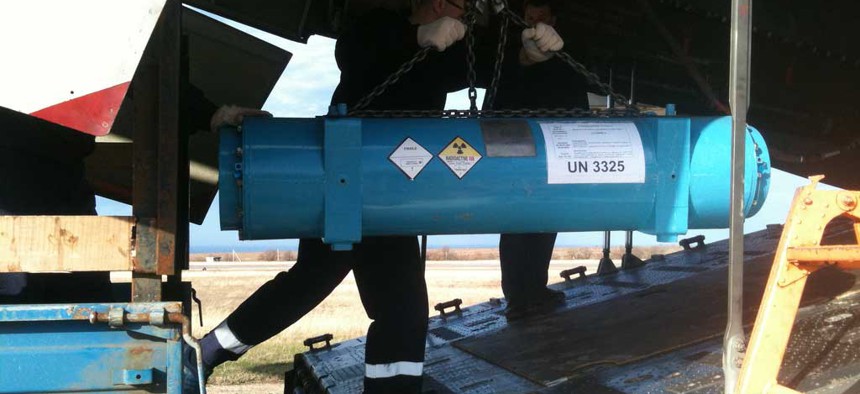
An NNSA employee loading a cask of HEU onto a cargo plane NNSA
After Crimea, U.S. Nuclear Agency Reviews Russia Aid
The National Nuclear Security Administration is reassessing its assistance to Russia amid continuing tension over Ukraine. By Rachel Oswald
The U.S. Energy Department's nuclear-security arm is reviewing its assistance to Russia amid continuing tensions with Moscow over Ukraine.
The National Nuclear Security Administration assessment is part of an Energy-wide "ongoing internal review of Russian-related activities," department spokesman Bill Gibbons said in a statement last week. The review comes against a backdrop of Western concerns that Russian President Vladimir Putin's forces might seek to further encroach on former Soviet or Warsaw Pact territory following the annexation of Ukraine's Crimean Peninsula.
It was not immediately clear to what extent the Energy review would consider the nuclear-security and nonproliferation work conducted by NNSA officials. The Obama administration in the past has tried to insulate such U.S.-Russia cooperation from any foreign policy disagreements with the former Cold War rival.
However, at least one nuclear security assistance-related project already has been canceled. Gibbons said the agency had decided to drop a request in its fiscal 2015 budget proposal for funding training equipment that would be used by Russian security forces as they practice responses to possible attacks on nuclear-material transports or sites housing these sensitive materials.
"The [fiscal 2015] budget request was developed long before the current situation with Russia unfolded," said Gibbons, adding that the department had already decided to rescind the funding proposal before two U.S. lawmakers raised objections to the project in a recent letter sent to Energy Secretary Ernest Moniz.
Representatives Michael Turner (R-Ohio) and Jim Bridenstine (R-Okla.) warned in their March 24letter that it would be a "mistake" to continue providing Russia with the Multiple Integrated Laser Engagement System equipment. "It is difficult to imagine a worse time to provide military-grade technology" to Russia, the lawmakers wrote.
At the same time, Bridenstine appeared to mock the purpose of the technology transfer, calling it "laser tag" in a March 24 blog post.
The two House members also requested the department provide to them by the end of April a list of all fiscal 2015 NNSA funding requests for technology or service support to Russia. They additionally asked for an intelligence assessment of whether any of the technology intended for use in Russia could be utilized for purposes other than nuclear nonproliferation.
The laser equipment was to be used at a Rosatom training facility and at a Russian internal affairs ministry training center, where security personnel are instructed on how to protect civilian atomic sites in the country. The technology was meant "to support effective protective force performance testing," according to the Energy Department's fiscal 2015 budget proposal. The department had been seeking $1.9 million for the gear, according to an NNSA official who requested anonymity, lacking authorization to be publicly named.
It was unclear whether Turner and Bridenstine were satisfied with the Energy Department steps to stop transfer of the laser system. The lawmakers' offices said they were unable to offer comment on the matter by press time.
Kingston Reif, a policy analyst with the Center for Arms Control and Nonproliferation, said in an email that the decision to rescind the request for the laser technology "raises questions" about whether Pentagon and NNSA officials are reconsidering moving forward with other nonproliferation projects in Russia.
Over the years, Energy's semiautonomous National Nuclear Security Administration has provided billions of dollars in monetary, in-kind and technical assistance to Russia. The projects include a range of nuclear security and nonproliferation-related activities. A number of efforts to lock down and reduce vulnerable stockpiles of Soviet-era atomic and radiological materials have been concluded or are winding down, although some cooperative work has continued.
NNSA officials earlier this month acknowledged the situation in Ukraine likely would have an effect on efforts to hammer out language with Moscow on a new bilateral accord that would replace an expired nuclear-security cooperation umbrella agreement. However, the agency said it did not anticipate that any ongoing contractor work in Russia would be notably interrupted by the uptick in tensions with the Kremlin.
A sampling of some of the U.S.-Russia nuclear nonproliferation collaboration planned for fiscal 2015 includes wrapping up work on consolidating the remainder of Russia's most sensitive categories of atomic materials at a new high-security installation in the country; boosting physical protections at multiple sites that process bulk nuclear substances; and finishing security upgrades at entry points for two major weapon-design facilities.
NEXT STORY: Can the U.S. Still Confront Autocrats?
